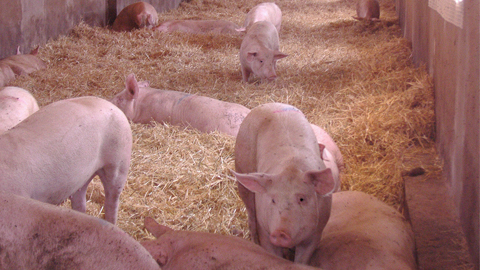The UAB leads a project to improve the welfare of farm pigs and dairy cattle

04/10/2019
Obtaining real-time images of the welfare of each and every farm animal. This is the objective of ClearFarm, a project led by the Faculty of Veterinary Medicine at the Universitat Autònoma de Barcelona (UAB) which includes 13 European institutions from 6 different countries. To reach its goal, it will develop and validated a platform which will use a series of sensors to collect data on the welfare of the animals and offer relevant information to farmers and consumers to aid in their decision-making processes.
Animal welfare has become a fundamental aspect of animal husbandry, but conducting continuous evaluations has proven to be a true challenge. “Through this project, we aim to foster innovation and make full use of the new technological possibilities to foster better animal welfare in every step of the production process and thus contribute to a sustainable production of pigs and cattle, the two largest animal production systems in Europe”, explains Xavier Manteca, researcher at the Department of Animal and Food Science at the UAB and coordinator of the project.
ClearFarm uses existing market sensors to control a wide range of variables related to the behaviour of animals, their physical and mental health, and environmental and productive impacts. For example, sensor collars are put on cow and pigs and in thermal chambers so as to know where they move around in the farm, how often they go to eat or drink, etc. Environmental sensors will also be placed to obtain information on the spaces where the animals are (temperature, humidity, CO2, etc.).
These data will be gathered by a connected platform which through an algorithm will provide easy-to-understand information on the welfare of the animals, adapted to each target audience. On the one hand, farmers will be able to consult through a website updated information on the state of the animals with emphasis on any alert signals that could help them or anticipate changes or improvements to be made. On the other hand, consumers will be able to learn about the welfare history of the product (meat or dairy) by scanning a QR code which will send them to the website.
The platform will be tested out at different pig farms and dairy cattle farms across several countries. The objective is to make the platform capable of informing on the state of welfare in a variety of production systems, while taking into consideration the geographic divergences within these systems in Europe.
Networking for the Improvement of Animal Welfare
An innovative aspect of this project is that consumers, producers and political authorities will all be involved in the design of this new platform.
During the months of October and November several workshops will be held with consumers and livestock farmers to learn about their needs and preferences in animal welfare and the most adequate ways to meet these needs. “Through design thinking methodologies we aim to gather all important actors so that their needs, ideas and perspectives are all fully represented, and make sure that the technological platform we are developing adjusts to their requirements”, Xavier Manteca points out.
ClearFarm, which will have a duration of 4 years and has received 6 million Euros from the European Commission, includes the participation of 6 universities and research centres, 5 small and medium-sized companies and 3 large companies: the Universitat Autònoma de Barcelona, Universidad de Murcia, ELPOZO Alimentación S.A and Cooperativa Ganadera del Valle de los Pedroches (Spain); Syntesa Partners and Associates A/S, Skov As Glyngore – Dol Sensors, Aarhus Universitet (Denmark), CONNECTERRA BV, Eshuis BV and Wageningen University (the Netherlands), Università degli Studi di Milano (Italy), Lluonnonvarakeskus and Hämeenlinnan Osuusmeijeri (Finland) and Cattle Watch Ltd (Israel).